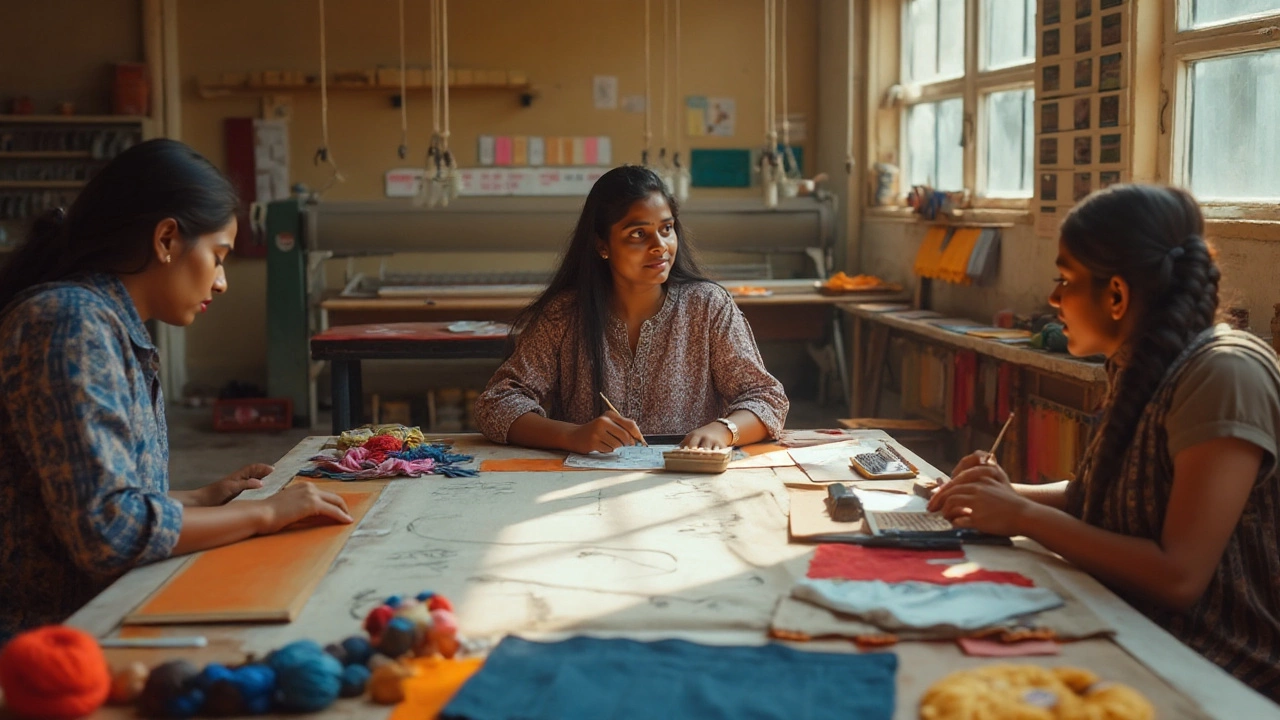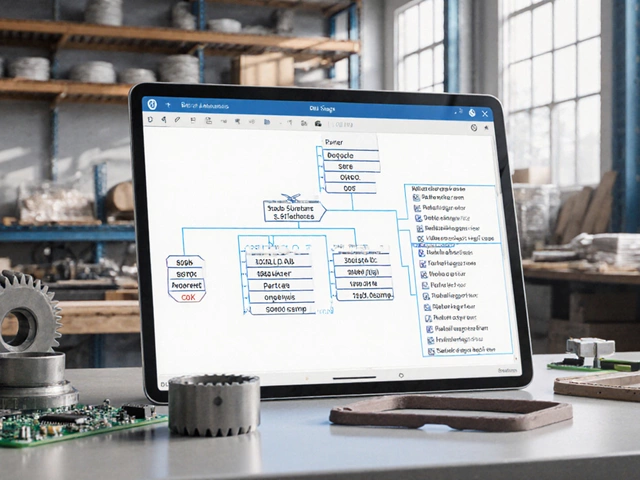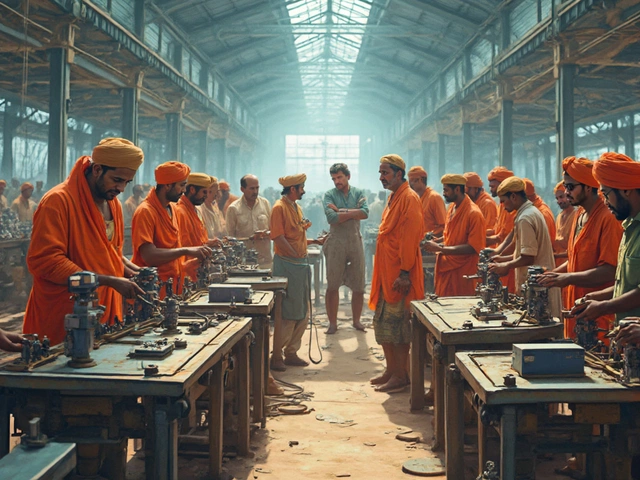You want a textile business in India that actually makes money, not just a factory photo for Instagram. Good-because this is a build-and-operate game. Expect real paperwork, some capital, and a sharp plan. The payoff? India’s textile supply chain is huge, export demand is steady, and niches are wide open-from knit tees to technical textiles. I’ll show you how to pick the right model, get your licenses, budget your setup, and land your first orders without burning cash.
TL;DR - Start a Textile Business in India in 2025
textile business in India
- Pick a model you can execute: small garment unit, power loom weaving, job-work (CMT), dyeing/printing, wholesale, or D2C brand. Avoid spinning unless you have deep pockets.
- Register fast: Udyam (MSME), GST, IEC (if exporting), Shops & Establishments, factory license (if workforce threshold is met), EPF/ESIC, fire NOC. Dyeing/processing needs pollution board consents.
- Start in a cluster to cut costs: Tiruppur/Ludhiana (knits), Surat/Bhiwandi (MMF fabrics), Erode/Karur (home textiles), Bhilwara (suiting). Watch the new PM MITRA mega parks too.
- Money math: a 20-machine garment line ≈ ₹25-35 lakh capex; a 10-loom powerloom shed ≈ ₹30-50 lakh. Keep 3-6 months of working capital.
- Profit is thin but scalable: target 8-15% EBITDA, 5-10% net. Win with efficiency, compliance, and fast turnaround.
Step-by-Step: From Idea to First Order
Think in jobs-to-be-done: choose a business model, set up legally, secure a location and utilities, find buyers, source inputs, then ship quality on time. Here’s the path that works.
-
Choose your model (and niche)
- Garment manufacturing (CMT/job-work): You sew for brands/exporters. Lower capex, faster start. Great for T-shirts, polos, leggings, kidswear, uniforms.
- Fabric weaving/knitting: Power looms/knitting machines. Medium capex. Sell greige fabric or finished dyed fabric.
- Dyeing/printing/processing: Higher compliance, medium-to-high capex. Good margins if you serve nearby units.
- Home textiles: Towels, bedsheets, napkins, cushions. Stable export demand; compliance-driven buyers.
- Wholesale/trading: Lower capex, higher working capital. Build sourcing + buyer network. Use credit discipline.
- D2C brand: Design-led, small runs. Focus on product-market fit, e-commerce, and returns management.
Quick filter: if you’re new and capital-light, start with a 20-40 machine garment line or a job-work unit inside a cluster. It’s easier to find orders and talent there.
-
Lock your market and buyer
- Domestic B2B: uniform distributors, regional brands, large wholesalers.
- Export B2B: small-to-mid buyers via fairs (Bharat Tex, IHGF, Heimtextil India) and sourcing portals. Start with samples and small trial orders.
- D2C: start with 3-5 hero SKUs. Push one channel first (Amazon/Myntra/own site), not everything at once.
Get a letter of intent or sample order before heavy capex. Your first buyer shapes machine choice, trims, and compliance.
-
Register your business and get the must-have licenses
- Business form: Proprietorship (fast, simple), Partnership/LLP (shared control), Private Limited (investor-friendly). Use a CA/CS for setup.
- Udyam Registration (MSME): To access MSME benefits and easier credit.
- GST Registration: Mandatory if you cross threshold or plan inter-state/exim.
- IEC from DGFT: If you’ll import/export.
- Shops & Establishments and local trade license from your state/ULB.
- Factory License: If you employ the threshold number of workers (commonly 10+ with power or 20+ without; check your state’s current rule).
- EPFO/ESIC: EPF when you hit 20 employees; ESIC typically from 10 employees (state-specific). Check EPFO/ESIC norms.
- Pollution Control Consents (CTE/CTO): Needed for dyeing, printing, processing, and in some cases for large units. State Pollution Control Board is the authority.
- Fire NOC and Building approvals: As per state fire services and development authority.
- Quality/compliance (as needed): ISO 9001, OEKO-TEX, GOTS/GRS, BSCI/SEDEX, ZDHC (buyers often demand these).
For claims that matter, don’t guess. Check primary sources: Ministry of Textiles, DGFT (for IEC), GST Council notifications, EPFO/ESIC, your State Pollution Control Board, and Bureau of Indian Standards where relevant.
-
Pick the right location
- Operate inside a cluster: Tiruppur (knit/garments), Ludhiana (knit/hosiery), Surat (MMF & embroidery), Bhiwandi/Ichalkaranji (power looms), Erode/Karur (home textiles), Panipat (terry/home), Bhilwara (suiting), Ahmedabad (composites).
- PM MITRA Parks: Seven mega parks announced by the Ministry of Textiles (Tamil Nadu, Telangana, Gujarat, Karnataka, Maharashtra, Madhya Pradesh, Uttar Pradesh) aim to offer plug-and-play infra and common facilities. Track state tenders and allotments.
- Export logistics: Prefer proximity to ports like Mundra, Nhava Sheva, Chennai, Tuticorin if you aim for exports.
- Power and water: Weaving, dyeing, and processing are power/water-hungry. Confirm uninterrupted supply and tariffs.
-
Buy machines and set your line up
- Garments: Start with 20-40 single-needle lockstitch, overlock, flatlock, button, bartack, cutting table, basic CAD, manual spreader, steam irons/compressors, QA stations.
- Weaving: Power looms/rapier/air-jet (depends on fabric), warping, sizing (if in-house) or outsource.
- Dyeing/printing: Jigger/jet/dyeing machines, stenters, dryers, ETP (and ZLD if applicable), lab equipment. Get a process consultant early.
- Safety/ergonomics: Needle guards, proper lighting, ventilation, fire exits, and PPE.
-
Source smart and standardize
- Shortlist 2-3 yarn/fabric/trim suppliers per item. Lock specs and test reports (GSM, shrinkage, colorfastness).
- Use quality gates: fabric inspection (4-point), in-line checks, final AQL inspection.
- Agree payment terms: start with small credit, scale as you build trust.
-
Win the first order and deliver
- Offer sampling fast (48-72 hours) and clear tech packs. Share SMV-based capacity.
- For exports, use LC or advance + balance against documents. For domestic, stage payments and PO with penalties for cancellations.
- Ship on time. A good on-time record beats a cheaper quote next season.

Licenses, Compliance, and Location Choices
Textiles run on thin margins, so compliance isn’t just legal-buyers use it as a filter. Get your files straight from day one.
Core registrations (typical flow)
- Incorporate (Proprietorship/LLP/Private Limited) → PAN → Bank account
- Udyam Registration (MSME) → GST Registration
- Shops & Establishments → Factory License (if workforce threshold met)
- EPF/ESIC as you add headcount
- IEC if importing/exporting
- State Pollution Control Board consents where applicable
- Fire NOC, building and layout approvals
Sector-specific notes
- Dyeing/printing/processing: You’ll need CTE/CTO, ETP, and in certain states like Tamil Nadu, Zero Liquid Discharge norms for processing clusters. Keep a full-time environment officer if you scale.
- Knits/garments: Compliance focus is worker safety and social audits. Many buyers ask for BSCI/SEDEX, OEKO-TEX Standard 100 for inputs, and chemical conformity (ZDHC MRSL).
- Technical textiles: Check BIS standards and end-use norms (e.g., PPE fabrics). Some categories fall under additional certifications.
Government support to track (2025)
- PLI for Textiles: Incentives aimed at MMF apparel and technical textiles. Watch Ministry of Textiles updates for windows and categories.
- PM MITRA Parks: Plug-and-play infra, common facilities, and integrated value chains. States are rolling out allotment processes.
- Skill schemes (SAMARTH): For workforce training in partnership with industry.
- Export rebates: RoDTEP and RoSCTL for garments and made-ups. Check current rates on DGFT/CBIC notifications.
- Credit: Mudra loans (Shishu/Kishore/Tarun), CGTMSE guarantee for MSME, SIDBI direct lending, and state textile policies (capex interest subsidies, power tariff support).
Why clusters matter
- Cheaper inputs: Yarn, dyes, trims are nearby.
- Skilled labor: Line supervisors, pattern masters, loom technicians are available.
- Faster turnaround: Dyeing, printing, embroidery vendors are next door.
- Compliance and testing: Labs and consultants are in the same ecosystem.
Costs, Funding, and Profit Math
Textiles are capital-light at the garment job-work level and capital-heavy at spinning/processing. Keep your first setup frugal and adaptable.
| Model | Typical Starter Capex (₹) | Monthly Fixed Costs (₹) | Gross Margin Range | Notes |
|---|---|---|---|---|
| Garment unit (20-machine line) | 25-35 lakh | 3-6 lakh | 18-35% on CMT | Fast start; depends on efficiency and rework rate |
| Garment unit (40-60 machines) | 50-85 lakh | 6-12 lakh | 18-35% on CMT | Better overhead absorption; needs steady orders |
| Power loom weaving (10 looms) | 30-50 lakh | 3-5 lakh | 10-20% | Margin swings with yarn and fabric realization |
| Dyeing/processing (small) | 1.5-4 crore | 8-20 lakh | 15-25% | Compliance-heavy; ETP/ZLD costs are material |
| Home textiles stitching unit | 20-40 lakh | 3-6 lakh | 12-25% | Export buyers value consistency and audits |
| Wholesale/trading | 5-15 lakh | 2-4 lakh | 5-12% | High working capital; credit control is key |
Rules of thumb
- Working capital: Keep 3-6 months of fixed costs + 1-2 production cycles of raw materials. Payment terms are often 30-90 days.
- Break-even: BEP (units) = Fixed Costs / (Selling Price - Variable Cost per unit). Track this weekly.
- Garment costing: CMT price ≈ (SMV × wage rate × (1/efficiency)) + overhead per minute + margin. Reduce rework and idle time first; machines come second.
- Export pricing: Quote FOB first; confirm INCOTERMS. Build in a 1-2% currency buffer. Use forward contracts when volumes justify.
- Profit targets: Aim for 8-15% EBITDA and 5-10% net once stable. If you’re at 2-4%, fix quality and line efficiency before chasing more orders.
Funding paths
- Bank/MSME loans: Mudra (Shishu/Kishore/Tarun), CGTMSE guarantee, SIDBI. Maintain clean GST returns and bank statements.
- State textile policies: Interest subsidies, power tariff support, capex assistance. Check your state’s 2024-2025 policy.
- Buyer financing: Some buyers advance against POs; negotiate for trims/fabric paid directly by buyer in early months.
- Leasing: Consider leasing specialized equipment (e.g., stenter) rather than buying on day one.
Risk control
- Input volatility: Hedge yarn/fabric with short-term contracts; avoid massive inventory unless prices are collapsing.
- Power outages: Budget for generators or ensure a high-reliability zone. Downtime crushes margins.
- Compliance risk: Keep permits current; sudden closures hurt reputation with buyers fast.
- Order cancellations: Use POs with cancellation fees; stage your raw material purchases; diversify buyers.

Examples, Checklists, Mini‑FAQ, and Next Steps
Here’s how a few paths look in practice, plus the checklists and answers most people need before signing a lease.
Example A: 20-machine knit garment unit in Tiruppur
- Capex: 30 lakh (machines, tables, compressor, basic CAD, irons).
- Team: 25-30 people (operators, helpers, QC, supervisor, merchandiser).
- Orders: 2-3 small brands, 1 exporter for overflow. Mix of T-shirts and polos.
- Throughput: 700-1,000 pcs/day at 50-65% efficiency initially.
- EBITDA: 8-12% in months 4-6 if rework <5% and on-time delivery >95%.
Example B: 10 power looms in Bhiwandi
- Capex: 40 lakh (looms, warping outsourced, small generator).
- Product: MMF shirting fabric for Surat traders.
- Margins: 10-15% typical; protect by locking yarn for a month and planning maintenance.
- Scaling: Add looms in 4s as orders stabilize; invest in humidity control for better quality.
Example C: Home textile stitching unit in Panipat
- Capex: 25-35 lakh; focus on hemming, piping, packaging.
- Buyers: Export houses needing surge capacity for towels/bed linen.
- Certs: OEKO-TEX linked suppliers, BSCI audit-ready premises.
Checklist - Before you spend rupees
- One anchor buyer with a trial order or LOI?
- Cluster chosen with 2-3 backup vendors for dyeing/printing/embroidery?
- Udyam, GST, IEC plan and timelines listed?
- Lease with power load sanctioned and clear fire exits?
- Machine mix mapped to your first two SKUs?
- Quality plan: fabric inspection, in‑line checks, AQL for final?
- Cash for 3-6 months fixed costs + first production cycle?
Checklist - First 90 days of operations
- Hire a production supervisor who can balance lines and track hourly output.
- Implement simple SOPs: bundle ticketing, WIP tracking, needle policy, metal detection (if buyer asks).
- Daily 15‑minute standup: yesterday’s output, defects, plan for today.
- Weekly costing review: SMV vs. actual minutes, rework %, absenteeism.
- Bookkeeping: tally invoicing, GST, vendor credits-clean data helps with loans.
Mini‑FAQ
- Do I need GST from day one? If you plan inter‑state sales or expect to cross the threshold, yes. Most buyers prefer GST‑compliant suppliers anyway.
- What margins are realistic? Manufacturing nets 5-10% once stable. Push efficiency before chasing bigger orders.
- Is PLI worth it for MSMEs? PLI is aimed at larger scale in MMF/technical textiles. MSMEs benefit more from state policies, Udyam-linked credit, and cluster infra.
- Should I buy or outsource dyeing? Outsource early. Bring it in‑house only when volumes and compliance capacity justify it.
- Export or domestic first? Domestic B2B is faster to start. Exports pay better but need documentation, quality systems, and currency planning.
Decision guide - What to start with
- Low capital, fast start: Garment job‑work, uniforms, kidswear, small D2C.
- Technical interest, medium capital: Power looms with cluster support.
- Process control, higher capital: Dyeing/printing in a park with common facilities.
Next steps
- Call three buyers in your chosen niche. Ask for a tech pack and sample order size.
- Visit the nearest cluster. Shortlist machine suppliers and processing partners.
- Finalize a small, audit‑friendly premises with the right power load.
- Incorporate and file for Udyam, GST, IEC (if exporting). Start fire/building approvals.
- Order machines and hire a battle‑tested supervisor before operators.
- Run a pilot order and document every minute from cutting to packing. Fix bottlenecks.
Troubleshooting by persona
- First‑time founder, short on capital: Start with 10-15 machines, sublease floor space inside a bigger unit, share cutting/finishing, and prove delivery for 2-3 months before scaling.
- Trader moving into manufacturing: Keep trading alive to fund working capital. Start a 20‑machine line to capture CMT margin you’re currently outsourcing.
- Engineer eyeing processing: Intern for 6-8 weeks at a dye house. Your first crore is spent on ETP, utilities, and compliance. Get those right or don’t start.
- D2C dreamer: Contract‑manufacture first 3 runs. Invest in fit and returns management before you buy machines.
Keep it simple: one niche, one cluster, one reliable buyer, and one clean shop floor. Nail that, then add complexity. India’s textile engine rewards operators who deliver on time, every time.






